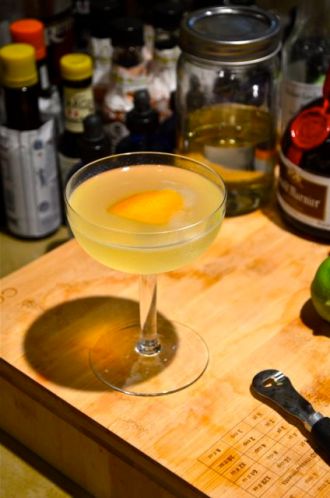Weekly Cocktail #58: Embury’s Larchmont
Contributed by on Sep 06, 2013
Zero readers love this post.
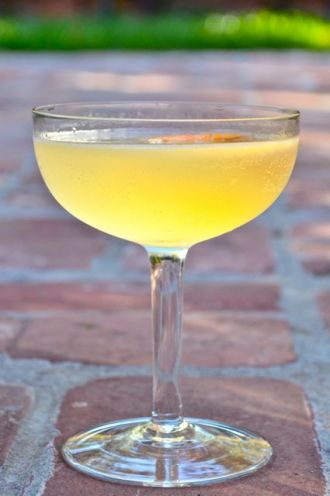 Well, summer is “over”, at least in the family sense. Kids are back in school, work cranks up, and the holidays are already an insidious little whisper in your ear. So it starts again. Good thing Autumn also brings the harvest, the fall colors and (in Norcal) some good waves. And a few cocktails always help to re-acquaint oneself with “real life”.
Well, summer is “over”, at least in the family sense. Kids are back in school, work cranks up, and the holidays are already an insidious little whisper in your ear. So it starts again. Good thing Autumn also brings the harvest, the fall colors and (in Norcal) some good waves. And a few cocktails always help to re-acquaint oneself with “real life”.
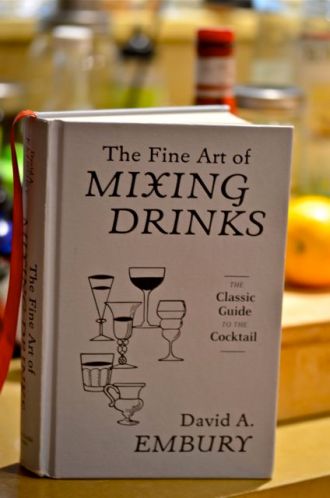 But before summer was over I did get to do a full read of David A. Embury’s famous 1950′s cocktail book “The Fine Art of Mixing Drinks“. Embury’s book is unique for a few reasons: he was a lawyer not a bartender and rather than simply list recipes he tried to design a way to classify cocktails in a more orderly fashion. And the book does succeed in giving any home (or pro) bartender a foundation for creating thousands of drinks. (Just ignore the often hilarious heath and medical advice, unless you are the type who thinks smoking is still good for you, then by all means, listen to “Dr.Embury”).
But before summer was over I did get to do a full read of David A. Embury’s famous 1950′s cocktail book “The Fine Art of Mixing Drinks“. Embury’s book is unique for a few reasons: he was a lawyer not a bartender and rather than simply list recipes he tried to design a way to classify cocktails in a more orderly fashion. And the book does succeed in giving any home (or pro) bartender a foundation for creating thousands of drinks. (Just ignore the often hilarious heath and medical advice, unless you are the type who thinks smoking is still good for you, then by all means, listen to “Dr.Embury”).
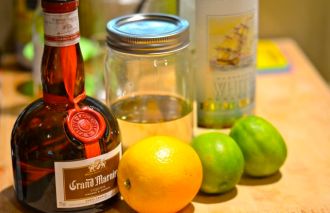 Embury makes the case that almost any cocktail is simply a base (the spirits) and modifiers (sugar, citrus, aromatic wines, bitters, liqueurs, etc.). He also classifies most cocktails into two families. The first family is “aromatic” cocktails using spirits with aromatic wines (vermouth, quinquina, sherry) and bitters, think Martinis and Manhattans. The second family of cocktails are the “sours”, drinks with spirits, citrus (usually lemon or lime) and a sweetener (sugar, syrups, liqueurs), think Daiquiri, Whiskey Sour, or (these days) a Margarita.
Embury makes the case that almost any cocktail is simply a base (the spirits) and modifiers (sugar, citrus, aromatic wines, bitters, liqueurs, etc.). He also classifies most cocktails into two families. The first family is “aromatic” cocktails using spirits with aromatic wines (vermouth, quinquina, sherry) and bitters, think Martinis and Manhattans. The second family of cocktails are the “sours”, drinks with spirits, citrus (usually lemon or lime) and a sweetener (sugar, syrups, liqueurs), think Daiquiri, Whiskey Sour, or (these days) a Margarita.
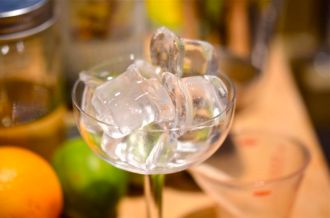 This system certainly works for most cocktails and other writers, most notably Gary Regan in the “Joy of Mixology“, expanded on these basic concepts. Good ideas and tools do seem to travel through time. But some of Embury’s concepts (along with his medical advice) have not aged quite as well. And in this case, we mean the proportions of his cocktails.
This system certainly works for most cocktails and other writers, most notably Gary Regan in the “Joy of Mixology“, expanded on these basic concepts. Good ideas and tools do seem to travel through time. But some of Embury’s concepts (along with his medical advice) have not aged quite as well. And in this case, we mean the proportions of his cocktails.
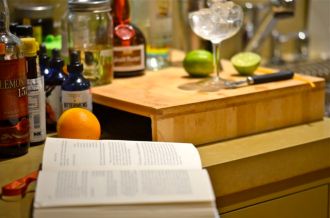 You see, Embury liked his cocktails dry. And we mean dry. For aromatic cocktails, he often liked a 7 to 1 (base to modifier) ratio, which fits many current tastes. But for sours, Embury suggests 1 part sweet, 2 parts sour and 8 parts spirits. Embury, it seems, liked to taste the booze in his cocktails. And while most of the drinkers here at the farm agree, we usually go 1 part sweet, 1 part sour and 2 parts spirits (and we see some recipes suggesting 1:1:1). But before we wrote off Embury’s ratios, we gave them a try in a few recipes.
You see, Embury liked his cocktails dry. And we mean dry. For aromatic cocktails, he often liked a 7 to 1 (base to modifier) ratio, which fits many current tastes. But for sours, Embury suggests 1 part sweet, 2 parts sour and 8 parts spirits. Embury, it seems, liked to taste the booze in his cocktails. And while most of the drinkers here at the farm agree, we usually go 1 part sweet, 1 part sour and 2 parts spirits (and we see some recipes suggesting 1:1:1). But before we wrote off Embury’s ratios, we gave them a try in a few recipes.
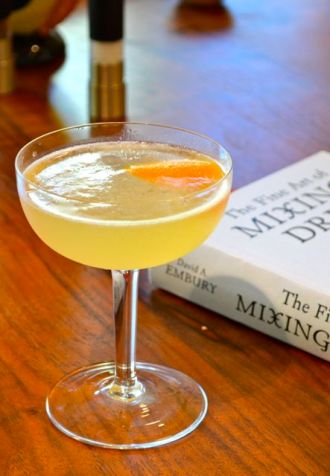 How did it go? Well, the drinks are very dry and we would prefer both a bit more sweet and sour. But we were surprised, particularly if big fans of the base spirit, how much we liked the drier cocktails. They don’t always work, but when experimenting with a recipe you like, we suggest trying an “Embury-esque” version, you may be surprised…..besides, you get to try another drink.
How did it go? Well, the drinks are very dry and we would prefer both a bit more sweet and sour. But we were surprised, particularly if big fans of the base spirit, how much we liked the drier cocktails. They don’t always work, but when experimenting with a recipe you like, we suggest trying an “Embury-esque” version, you may be surprised…..besides, you get to try another drink.
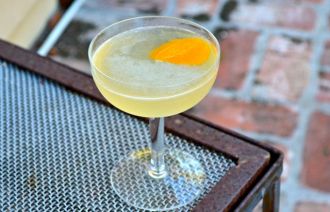 Interestingly, Embury has a recipe for one of his favorite sour cocktails, the Larchmont (a town in Westchester), that is a bit of a hack on his 1:2:8 ratio and is a good “gateway” into his style of mixing. The Larchmont, a Daiquiri variant, combines 1/2 part simple syrup, 2 parts lime juice, 2 parts Grand Marnier and 6 parts white Cuban rum with an orange peel garnish. Since we think of Grand Marnier (not a common mixer) as mostly sweet, this recipe does balance sweetness with what is still a very spirit-forward cocktail.
Interestingly, Embury has a recipe for one of his favorite sour cocktails, the Larchmont (a town in Westchester), that is a bit of a hack on his 1:2:8 ratio and is a good “gateway” into his style of mixing. The Larchmont, a Daiquiri variant, combines 1/2 part simple syrup, 2 parts lime juice, 2 parts Grand Marnier and 6 parts white Cuban rum with an orange peel garnish. Since we think of Grand Marnier (not a common mixer) as mostly sweet, this recipe does balance sweetness with what is still a very spirit-forward cocktail.
But a very, very good cocktail. Both Carolyn and I thought this was a truly well-balanced sip. We did use white Demerara rum and perhaps a few more drops of sugar than Embury would like, but the flavors were delightful. We got orange on the nose from the twist and Grand Marnier, a smooth lime sip with just a touch of heat from the rum and a slight cognac-ish note at the finish. The drink was sour, but had just enough sweet to let the other flavors lead. So if you want to try Embury’s dry style of sour cocktails, we suggest you first try the Larchmont. It softens the transition to come….
The Larchmont:
Ingredients:
- 1 1/2 oz. white rum (El Dorado)
- 1/2 oz. Grand Marnier
- 1/2 oz. lime juice
- Scant 1/4 oz. simple syrup
- Orange twist, for garnish
Assemble:
- Combine the liquid ingredients in a cocktail shaker with ice. Shake until well-chilled and strain into a chilled cocktail glass or coupé. Twist the orange peel over the glass and add to the cocktail. Serve.
Related articles
- Cocktail construction (3quarksdaily.com)
- Classy Cocktails (cocktailtube.net)
- Cocktail of the Month: The Sidecar (todaysnest.com)
- Sneak Peek: Grand Marnier Raspberry Peach (examiner.com)
- Peruvian Pisco Sour (happinessandhominy.wordpress.com)
- PF Flip cocktail -Did you just put an egg in my drink!? (thedrunkencrane.com)
- Happy Birthday Mr. Embury (meerkatproductsltd.typepad.com)
Filed under: All Recipes, Cocktail Recipes, Rum / Cachaca Tagged: cocktail book, Cocktails, cooking, David Embury, DrinkWire, Fine Art of Mixing Drinks, food, gardne, larchmont cocktail, mixing drinks, photography, photos, recipes


